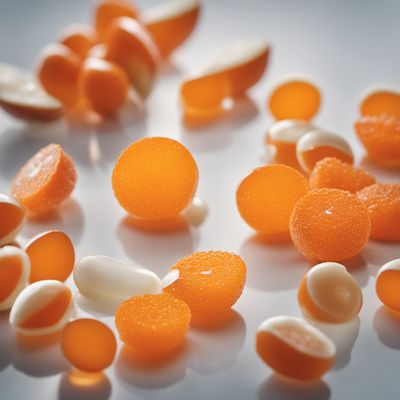
Ingredient
Vitamins
"The Essential Nutrient Powerhouses: Unveiling the Secrets of Vitamins"
Vitamins are micronutrients that are required in small quantities but have a significant impact on our health. They are classified into two categories: water-soluble vitamins (such as vitamin C and B-complex vitamins) and fat-soluble vitamins (such as vitamins A, D, E, and K). Each vitamin has unique characteristics, taste, texture, and appearance. While some vitamins are crystalline solids, others are oily liquids. They can range from colorless to vibrant hues, and their taste can vary from sour to bitter or even tasteless. Vitamins are essential for maintaining healthy skin, boosting the immune system, supporting bone health, promoting good vision, and aiding in various metabolic processes.
Origins and history
The discovery of vitamins dates back to the late 19th and early 20th centuries when scientists began to recognize the importance of certain dietary components in preventing deficiency diseases. The term "vitamin" was coined by Polish biochemist Casimir Funk in 1912, derived from the Latin word "vita" meaning life. Since then, extensive research has been conducted to understand the role of vitamins in human health, leading to the development of dietary guidelines and recommendations.
Nutritional information
Vitamins are essential for maintaining optimal health and are necessary for various bodily functions. They do not provide calories themselves but are crucial for the metabolism of carbohydrates, proteins, and fats. Each vitamin has its own set of nutritional benefits, such as vitamin C's antioxidant properties, vitamin D's role in calcium absorption, and vitamin A's contribution to vision health.
Allergens
Vitamins themselves are not known to cause allergies. However, some supplements or fortified foods may contain allergens such as soy, gluten, or dairy, so it is important to check the labels for potential allergens.
How to select
When purchasing vitamin supplements, it is important to choose reputable brands that adhere to quality standards and have undergone third-party testing. Look for certifications such as USP (United States Pharmacopeia) or NSF (National Sanitation Foundation) to ensure the product's quality and purity. For obtaining vitamins through food, opt for fresh, organic produce that is free from bruises, blemishes, or signs of spoilage.
Storage recommendations
To maintain the freshness and potency of vitamin supplements, store them in a cool, dry place away from direct sunlight. For fresh produce, store them in the refrigerator to slow down vitamin degradation. It is important to follow the storage instructions provided on the supplement packaging or consult a healthcare professional for specific recommendations.
How to produce
Vitamins cannot be produced by amateurs as they are organic compounds synthesized by living organisms. However, individuals can grow their own fruits and vegetables rich in vitamins by maintaining a home garden or participating in community-supported agriculture programs.
Preparation tips
Vitamins can be obtained through a balanced diet that includes a variety of fruits, vegetables, whole grains, lean proteins, and dairy or dairy alternatives. To maximize the vitamin content, it is advisable to consume fruits and vegetables raw or lightly cooked. Avoid overcooking or prolonged exposure to heat, as this can lead to nutrient loss. Additionally, pairing certain foods together can enhance the absorption of fat-soluble vitamins. For example, consuming vitamin A-rich foods with a source of healthy fats can improve its absorption.
Culinary uses
While vitamins themselves are not used as standalone ingredients in culinary applications, they are essential components of various dishes and recipes. Fruits and vegetables rich in vitamins are commonly used in salads, smoothies, juices, stir-fries, soups, and sauces. Vitamin-fortified foods and beverages are also available in the market, providing convenient options to incorporate vitamins into daily meals.
Availability
Vitamins are universally available in the form of supplements and are commonly found in a wide range of foods. Fruits, vegetables, whole grains, lean meats, dairy products, and fortified foods are all sources of vitamins.
More ingredients from this category » Browse all

Vitamin E (tocopherols, tocotrienols)
The Antioxidant Powerhouse

Vitamin K (phylloquinone, menaquinones)
The Mighty Nutrient: Unveiling the Power of Vitamin K

Vitamin B12 (cyanocobalamin, hydroxocobalamin, methylcobalamin)
The Essential Vitamin: Unveiling the Power of B12

Vitamin D (cholecalciferol, ergocalciferol)
"The Sunshine Vitamin: Unlocking the Power of Vitamin D"

Vitamin A (retinol, carotenoids)
The Vision Booster

Vitamin C (ascorbic acid)
The Immunity Booster: Unveiling the Power of Vitamin C

Vitamin B5 (pantothenic acid)
The Essential Nutrient: Unveiling the Power of Vitamin B5

Vitamin B3 (niacin, niacinamide)
The Essential Nutrient: Unveiling the Power of Vitamin B3

Vitamin B1 (thiamine)
The Essential Energy Booster

Vitamin B6 (pyridoxine, pyridoxamine, pyridoxal)
The Essential Nutrient Trio: Unveiling the Powers of Vitamin B6

Vitamin B2 (riboflavin)
The Radiant Nutrient

Vitamin B9 (folic acid, folinic acid)
The Essential Nutrient for Cell Growth and Development